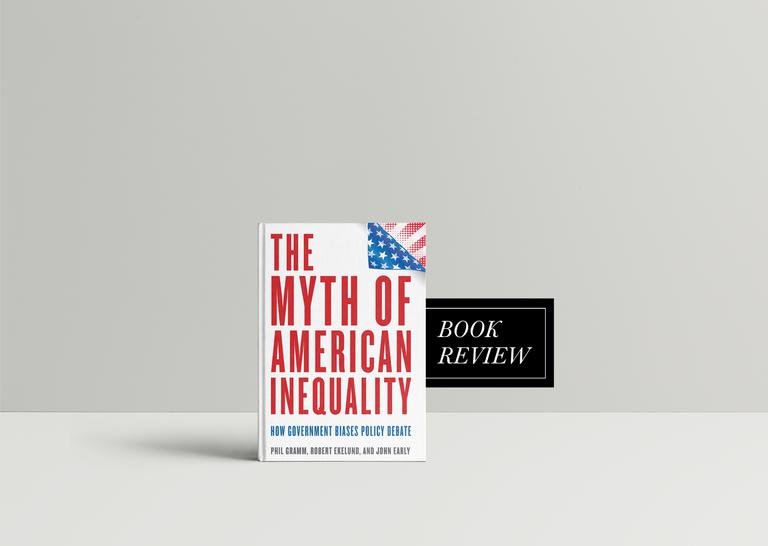
Economy
Rick Farmer, Ph.D. | December 13, 2022
Economists bust the myth of income inequality
Rick Farmer, Ph.D.
Many on the left have a moral objection to the idea that people who are more productive should have more buying power than those who are less productive. This leads to arguments over income equality. There are two major problems with the left’s premise. First, the desire for buying power incentivizes production, which benefits us all. Second, the left simply has its facts wrong.
In their new book The Myth of American Inequality: How Government Biases Policy Debate, economist (and former U.S. Senator) Phil Gramm and economists Robert Ekelund and John Early tackle both of these issues. They demonstrate that the buying power of American households is far more equal than the left admits and they discuss the societal benefits of productivity.
Official U.S Census Bureau statistics show an income gap of 16.7 to 1 between the top 20 percent of American households and the bottom 20 percent. But long ago the Census Bureau decided not to count as income more than two-thirds of the government benefits going to the poor. Also, the Census Bureau does not subtract taxes paid from income. When these adjustments are made the actual income difference is 4.0 to 1.
After adjusting for family size, transfer payments, and taxes, the per capita income for people in the bottom quintile is actually higher than those in the second and middle quintiles.
As Gramm is fond of saying, “In a free society you can debate what the level of income distribution ought to be, but it is much harder to argue that we ought to be redistributing more when the number is 4 to 1 rather than 16.7 to 1.” Let’s start by getting the facts straight.
The Census Bureau is one of the greatest data-collection agencies in the world. How could they get this so wrong? Gramm, Ekelund, and Early do not dispute the Census numbers. They dispute the assumption that, in the equality debate, benefits like child tax credits and Medicaid are not income. They also dispute the notion that taxes paid should be counted as income in these comparisons.
Using official government statistics from other agencies, such as the U.S. Bureau of Labor Statistics and the Internal Revenue Service, the authors recalculate the average income for each quintile of American households. The results are astounding.
After adjusting for family size, transfer payments, and taxes, they show that in 2017 the per capita income for people the Census identifies as in the bottom quintile is actually higher than those in the second and middle quintiles. They are not poorer. They are better off than people in median income households.
How is this possible? In 2017, $2.8 trillion—22 percent of earned income—went to transfer payments. (In an appendix, the authors list more than 100 government transfer programs, most of which are not counted as income to the recipients.) Consider, for example, that if a “low income” family receives Medicaid, food stamps, and housing assistance, the benefits quickly climb to thousands of dollars per month. Multiply that by 12 to see that the average annual benefit in 2017 was (you had better sit down) $45,398.
The left claims that income inequality and poverty are growing. It turns out that both have declined over the years, thanks to the generosity of the American taxpayers. When accounting for transfers and taxes, income inequality since 1947 has not grown 22.9 percent, as is commonly alleged—it has declined 3.0 percent. More importantly, poverty in America is not 12.3 percent, it is 2.5 percent. In fact, the U.S. has made so much economic progress that only 1.6 percent live at an economic level that would have been in the bottom 20 percent in 1967.
These sound like major victories to be celebrated. But Gramm and his co-authors quote President Lyndon Johnson as saying a goal of the War on Poverty is “to allow them to develop and use their capacities.” Unfortunately, the incentives are so upside down that labor participation rates in the bottom quintile have plummeted to 33 percent.
Those in the bottom quintile, having as much or more spending power as those in the middle quintile, are not incentivized to go to school, seek work, look for a better job, and so on. This, the authors argue, is costing society the creative and productive energies of those who could be contributing.
All around us we see people who are struggling. It would be wrong to abandon them. But it is important that we be realistic about the amount of services being provided and that we get the incentives right.
The authors offer four policy prescriptions.
Require the government (Census Bureau and others) to produce a report that properly adjusts for transfers, taxes, and inflation.
Include a work requirement in every means-tested program. Many of the work requirements put in place in the 1990s have been diluted or eliminated.
Put parents in charge of their children’s education. The book spends seven pages reviewing the research on the benefits of school choice.
Eliminate unnecessary licensing requirements. They create barriers to those who seek to improve their circumstances.
This book is written at a level that most high-school graduates can understand. Yet it has enough detail that it could be used as a college textbook. Best of all, it tells you most of what you need to know in the first twelve pages. It is a must read and a great reference for anyone engaging in the debate over income inequality in America and what, if anything, should be done about it. (A video of Gramm and Early discussing the book at the American Enterprise Institute is here.)
Gramm says he and his co-authors did not write the book to end a discussion, but rather to start one. The conversation should begin with an accurate set of statistics. They achieved their goal in this book. “It ain’t what you don’t know that gets you into trouble,” goes the old quote attributed to Mark Twain. “It’s what you know for sure that just ain’t so.”

Rick Farmer, Ph.D.
Dean of the J. Rufus Fears Fellowship
Dr. Rick Farmer serves as OCPA’s Dean of the J. Rufus Fears Fellowship. Previously, Rick served as director of committee staff at the Oklahoma House of Representatives, deputy insurance commissioner, and director of the Oklahoma Workers’ Compensation Commission. Earning his Ph.D. at the University of Oklahoma and tenure at the University of Akron, Rick can best be described as a “pracademic.” While working full-time in the Oklahoma government, he continued to teach and write. He served as president of the Oklahoma Political Science Association and chairman of the American Political Science Association’s Practical Politics Working Group. In 2016, he was awarded the Oklahoma Political Science Association’s Lifetime Achievement Award. Farmer has appeared on CNN, NBC, MSNBC, C-SPAN, BBC Radio, and various local news outlets. His comments are quoted in the Los Angeles Times, Wall Street Journal, Christian Science Monitor, and numerous local newspapers. He is the author of more than 30 academic chapters and articles and the co-editor of four books.